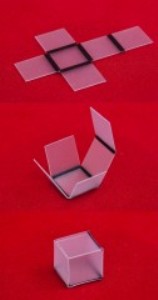North Carolina researchers have devised an easy technique for the conversion of two-dimensional objects into three-dimensional objects utilizing only light. The technique involves running a pre-stressed plastic sheet through a traditional inkjet printer in order to print prominent black lines on the sheet.
 "The new technique can be used to create a variety of objects, such as cubes or pyramids, without ever having to physically touch the material."
"The new technique can be used to create a variety of objects, such as cubes or pyramids, without ever having to physically touch the material."
The sheet is then sliced to form a specific pattern and then mounted below an infrared light. The energy absorption at the bold black lines is higher than that across the remaining material, resulting in contraction of the plastic sheet forming a hinge, thus creating three-dimensional patterns.
By using this method, it is possible to form a range of objects that include pyramids or cubes, without the need of physically touching the sheet. This method can be used with commercial printing methods, for example, roll-to-roll printing, screen printing and inkjet printing that are less expensive but are two-dimensional. In order to alter the extent to which each hinge folds, the width of the hinge or black line is altered. For instance, it is possible to form a hinge that folds 90° and 120° for a cube and pyramid, respectively. It is important to note that folding of wider hinges is quicker, since there is a larger surface area for energy absorption.
According to the assistant professor of biomolecular and chemical engineering at NC State and this research paper’s co-author, Michael Dickey, the lines on both sides of the sheet can also be patterned causing the hinges to fold in a number of directions. This enables the formation of complicated structures.
3-D Objects, Just Add Light
In order to explain the technique, researchers formulated a computer-based model and arrived at two major findings. Firstly, the hinge’s surface temperature must be higher than the material’s glass transition temperature, which is the material’s softening point. Secondly, heat must focus on the hinge to ensure quick and efficient folding. Folding will not occur if all the material is heated to the glass transition temperature.